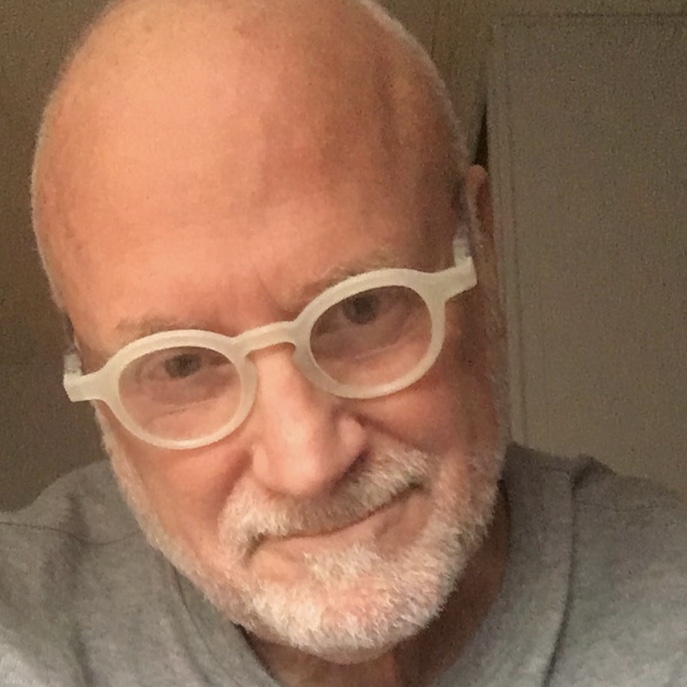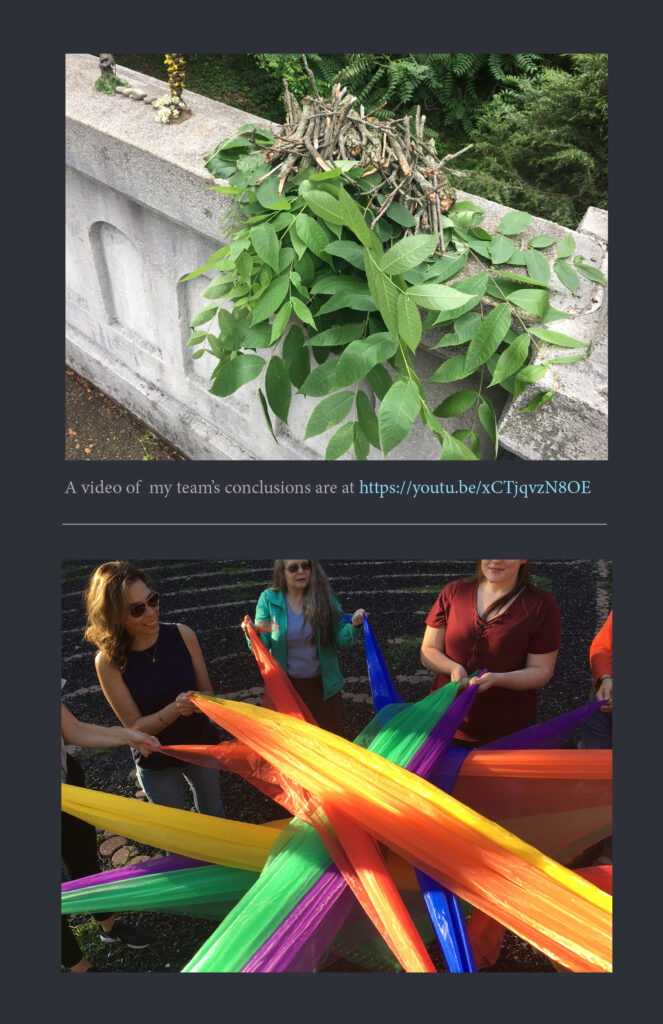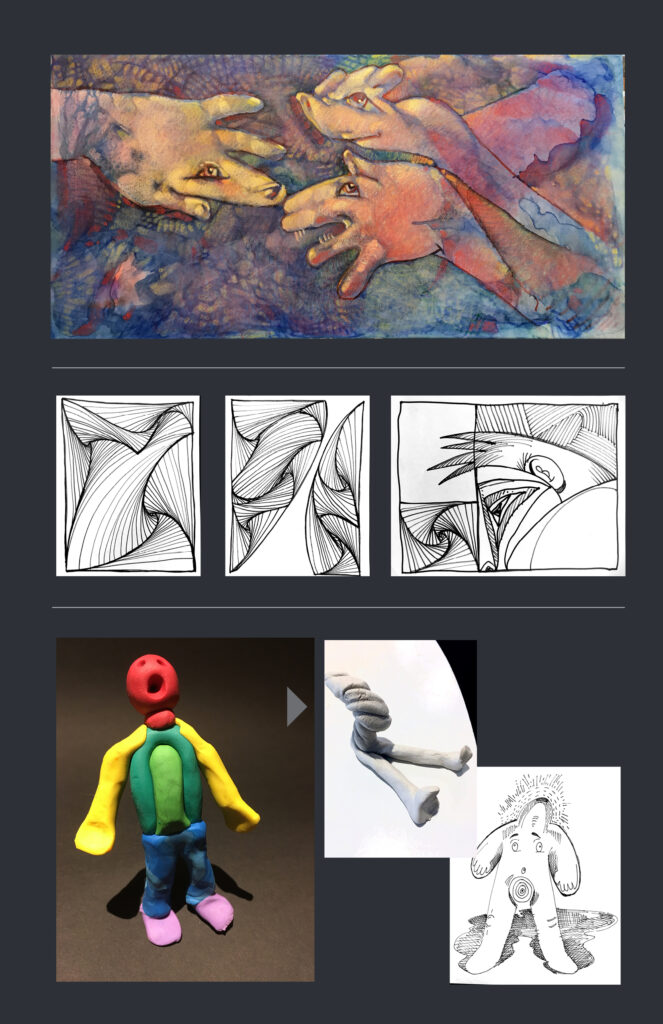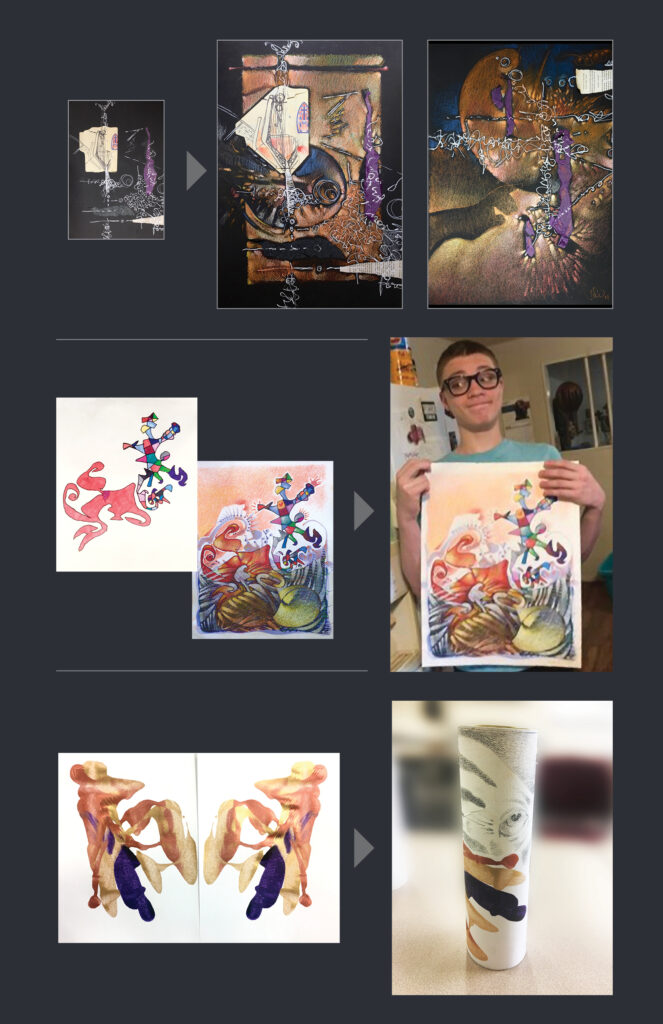
Jonathan Soard

The only man in a cohort of 47 students, in the Fall of 2018, I was one of the oldest in any room at residency. This must be understood, for the rest of this statement to make any sense. I have spent the majority of my years on the fringes of tradition for a number of reasons I won’t mention here, but the sense of alienation I brought with me into the first residency has made a lasting impression that I will carry with me as continue to build my identity as an art therapist.
In that first residency I had my first experience with art-on-demand (and my first collage since undergrad school many years ago). I am sure that to the instructor, it must have seemed like a simple exercise, but to me the assignment was in complete opposition to what I had spent cultivating as an artist for 40 years. This was the beginning of the transformation that I have experienced while in the program. As for collage as an expressive art form, it wasn’t until years later, in Career Counseling with Prof. Miller, that I completed an assignment as a digital collage, by choice. I finally felt the power of collage, and on my terms in a media of my choice. In these two examples of collage at two different stages in my training, I was impressed with the notion that I must meet the client where they are as opposed to expecting compliance with an art “assignment.”
Transformation continued when my Mom died in May 2019. Again, a sense of alienation as an “orphan” in a world that suddenly seemed very big and very empty. This is when I allowed my work in art therapy to fill the void left by biological family. In June, at summer residency in a team of four, we wordlessly explored our environment on campus in Dr. McNutt’s experiential, and I found the beginning of closure with Mom’s passing. I built a small structure, like a crypt that held a small effigy of Mom made from the clay soil of The Woods. She was nestled inside, and I experienced a sense of peace. A video of this environmental assemblage and my team’s independent conclusions are at https://youtu.be/xCTjqvzN8OE. I was beginning to internalize “trusting the process” and began to think clinically to envision how I would use this experiential someday with others who had experienced loss.
That same Summer term, I started to feel the power of the Group. I had lost sight of it in artistic solitude over the years. Prof. Miller provided bright colored sashes and a thoughtful syllabus, and we collectively made a potent memory. An image of that memory is a part of my video. As an artifact of advancing trust and receding alienation, I began a collaborative project with Amanda Allard Cline, also in my cohort. We had a budding rapport and we challenged each other… in a good way. I provided black paper at the end of Spring term and they supplied the first marks and collage the following Fall. I immediately cut the paper in half and completed both sections as separate drawings. Amanda had first choice of the completed drawings and I was very happy with the other. It was during this exercise that I understood that working collaboratively with someone not only gave me insights into how they thought and felt, it gave me insight into how I thought and felt. I have used collaborative methods with clients since this experience and have witnessed how powerful a collaboration can be. It has on occasion, brought me as the therapist, and client into equilibrium, and helped establish a patient/therapist alliance.
Long distance collaboration has been another chance to connect and expand my ability to trust. In this instance, Sarah Taylor had heard about my collaboration with Amanda and asked me to consider a cooperative piece with her ward, Braden. After months, in his own time, Braden produced a drawing, sent it to me, and I dialogued with the drawing and took it where it wanted to go. I am told that when I sent the drawing back, He asked how I knew what he wanted. Authentically channeling Dr. Fish, I said the drawing told me what to do.
I’ve begun to integrate the Expressive Therapies Continuum in client treatment. I used a repetitive line technique that is illustrated in my video, that was effective in creating a soothing, rhythmic focus into an intervention that had a “cool” conclusion. In instances where it was appropriate, clients with sufficient motor skills would create a line-drawings in this technique which would then be copied and colored by those with lesser skill.
Another year of alienation and growth, 2020 brought with it the threat of a pandemic and the far more immediate specter of cancer. A lengthy series of drawings-as-art-based-research called The Amygdala Series was response art to loss and grief exacerbated by the physical distancing required by a rampant virus. and spawned a derivative series of art-based research called Cancer Mandalas. There are now hundreds, with no sign of stopping. A better understanding of the Amygdala’s power, primal and reactionary, has become a facet of my transformation into an art therapist. Someone who could respect the need to either fight or flee while recognizing the base impulse, could allows me to act and not react as a tool in both recognizing and bracketing both bias and countertransference.
Through practicum and then into Internship 1, Dr. Fish gently guided me toward response art as a way of bracketing countertransference and other bias. I began to understand active imagination as a means to learn directly from art in the form of dialogues. One drawing of a client’s eye that I had done to process their forcible restraint at my internship site, added depth and meaning to the Cancer Mandala Series through digital manipulation which is also a part of my contribution to our exhibit and my video. I have also included clay figure done for class as a color body-map-of-feelings, in 3-dimensions, as another art-on-demand assignment. My growth was marked by the ease of using a medium I rarely use in a manner that was foreign. I look at it now and feel how it expresses adjustment angst that I was going through at the time. That figure lead me to a twisted, air-dry clay figure that was made to model behavior for juveniles in detention as a shadow-self. I internalized this visual vocabulary of a representational figure recently as a Genderbread Man that carries with it a similar spirit.
My development as an art therapist has enriched my life as an artist. I had previously believed that an artist must walk around with a substantial ego to withstand the difficult life that most artists endure. While it is true, artists tend to have sizable egos and I can’t say that mine has, or will, become right sized but at the end of things, like our program, it is a good time to reflect. This exhibit is a reflection with tangible evidence of the process. From a book read in my formative years, I now know, “You look at where you’re going and where you are and it never makes sense, but then you look back at where you’ve been and a pattern seems to emerge,” Robert M. Pirsig, Zen and the Art of Motorcycle Maintenance, 1974.
Collage Collection, art-on-demand 1st semester residency and digital choice Fall 2020, are a comparison illustrating growth over the course of our degree.
Group Collection that captures two experientials that helped me deal with personal grief and accept the power of groups in healing. The top image is a symbolic tomb and the bottom is a symbolic construction of connectedness.
Individual Collection that illustrates an emerging identification of self with traced hands, the individual figure, and an ETC drawing technique that creates in introspective illusion for both me and for clients.
Collaboration Collection illustrates how a sense of group and redefined sense of self allowed me to connect with others in making art. I have since learned that making art with clients helps build a therapeutic alliance.
2020 Collection is bound up with frustrations imposed by life and disease. The Amygdala Series represented at top is called “My Body is a Battle Ground,” one of dozens of pieces that were art-based research of my fight or flee responses this year. They showed me how to bracket my biases and illuminate countertransference so I can act more than react to the recent events. The Amygdala Series informed the other pieces below that are digitally manipulated drawings that became a series of Cancer Mandalas.
Response Art Informed Cancer Mandalas begins with the top left image, a drawing of a patient’s tear-dropped tattooed eye afterbeing chemically restrained when she couldn’t control an angry outburst. The rest are derivative Cancer Mandalas that now number into the hundreds with no signs of stopping for a while.






12 Comments